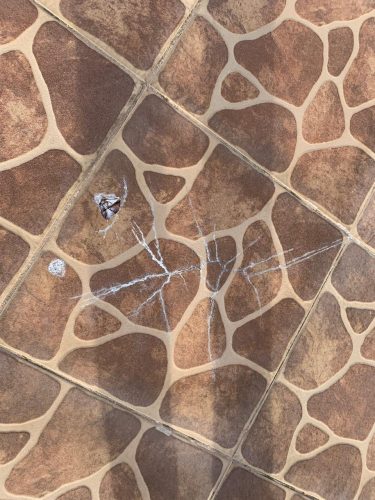-hydrocarbons ruled out
By Milton Grannum
The recent mystery seepage through tiles in several homes at Crane, West Coast Demerara is likely to be some type of hydroxide based on the EPA’s preliminary findings and hydrocarbons have been ruled out.
The revelation was made during an interview with Stabroek News yesterday, which included Executive Director of the Environmental Protection Agency (EPA), Kemraj Parsram; Senior Lecturer at the University of Guyana Chemistry Department and Chemist Patrick Ketwaru; and Head of the Emergency Response Team Joel Gravesande at the EPA’s head office in Georgetown.
Over the last month, several Crane residents have been in limbo after a substance oozed up under tiles in their houses.

During the interview yesterday, Parsram stated, “It is nothing of significant concern. If there was, then we would’ve told them to evacuate, but we told them to take precautions, ventilate, and avoid the area until we can give further directions. Our air quality test revealed that the air quality is all within the World Health Organization standards for air quality. There is nothing of significant concern, whether it is sulfur dioxide, volatile organic compounds beyond what is baseline or normal. In fact, it was almost (undetectable). It is not oil, it is not gas. From the observation and the test, it is not petroleum activity, it is not radon gas. It is clearly moisture coming up and moisture interacting with the tile, and the type of tile it is a clay-based tile. Clay and moisture resulted in this chemistry.”

The EPA press release said that “Analysis of the samples by Forensic Laboratory and the Pesticides and Toxic Chemicals Control Board (PTCCB) confirmed that no petroleum-based hydrocarbons were found in the samples. Physical observations and expert analysis also indicated that the substance found on the tiles was not petroleum-based.
“Air quality results indicated that the overall air quality is good and is within World Health Organization (WHO) standards for the locations assessed.
The EPA advises affected residents to continue to keep the area ventilated to allow for proper air circulation.
Malfunction
Parsram clarified that the initial EPA report, which indicated high sulfur dioxide levels in the home of Basmatie Singh, was inaccurate and due to equipment malfunction.
“I will be honest, that was an equipment malfunction. When we saw that, we came here (at the EPA) and we did one here, and it revealed the same thing. That is why we got an independent assessment done. It was done by the Environment Management Consultants. So we are now sending it overseas to have it recalibrated”, he said.
Ketwaru added, “If it was sulfur dioxide, we would’ve smelled it. You smell sulfur dioxide. Even if it was sulfur dioxide, it doesn’t mean it is petroleum-based. Even the house next to the rice field you can get rotten vegetation. So we have to take that into consideration also because the house is close to where they put pesticides. The rice field is on both sides of the house and the back. It is something that could’ve happened whether or not they put down the (gas) pipeline”, he said.
He then explained the formation of the substance and why he suspects it to be hydroxide. “When I took up the tile, I noticed there was moisture. If you are to take any plastic material and put it over concrete, when you remove that, you would notice moisture. That is what happens in our environment.
But what is more compounded, is because of the location, a much higher amount of moisture came up, hit the bottom of the tile, and then simply came up through the thin set. I deliberately touched the liquid to see what it was. It had a slimy, soapy feel, which immediately told me it is likely to be hydroxide. They had done some tests which showed it had a high pH. I went to a pipe in the yard and washed the substance off. If it was oil-based, it would not have washed off. That is what led me to ask the labs to do specific tests which confirmed we don’t have any hydrocarbons. We can do the test qualitatively, but because of the amount of the substance, we can’t quantify the concentrations since it is so low. But qualitative analysis because of the sensitivity of the equipment at the labs allows us to identify these compounds. We actually confirmed the anions and the cations, which indicate that there is a lot of calcium hydroxide, which was coming through the tiles and at the sides. There is also something called efflorescence in concrete and tiles it’s where that same thing happens, and if the tile is not of a high quality in terms of its resistance to alkali, it could gradually soak through the tile and then come up in little droplets on the tile out of nowhere. When the moisture comes through the concrete, the moisture dissolves out the cations, that is, the calcium, and then in the presence of water, it reacts with the water to make hydroxide, and it is that which comes up that gives us that high ph. This also would soak into the tile and penetrate. It also came out first at the side. This is what is happening at both homes. When the hydroxide comes up, it will now penetrate the tiles and gradually erode and come through.”
Due to the small sample size, however, the investigation was prolonged, and additional samples were needed. “The test will take time because of the sample size. If we get more of the substance, we will continue to test. That is why we ask them to be patient because we don’t want anything happening. In fact, the Ministry of Health is advising on the nauseous feeling, so we have to do further chemical analysis. That is why the investigation is taking a while. We will keep visiting. Tomorrow, we will visit again to get more samples and update the residents because we want to keep them informed, and we want to see if anything else other than moisture comes up. If nothing more arises, we know it is nothing to worry about already, but it could also be the tile reacting then it is a civil engineering problem they would have to sort out,” Parsram added.
Unnamed
When asked about other residents with similar situations who preferred to go unnamed, noting that it could be a different issue he urged them to come forward and also stated that “Tiles can pop from bad workmanship; it can be from vibrations and natural movement of the earth also. “The fact that the air quality was tested and it says there is no gas says there is nothing to worry about.”
They also ruled out gas station seepage, explaining that gasoline’s distinct odor would have been noticeable.
Parsram assured residents there is no need to move but advised avoiding the seepage area. “When we say we are doing further investigation, we are saying observations if they are smelling something that we are not detecting and if it is coming more and more. Once we are clear with that, we are good.”
Ketwaru added that handling the issue requires a careful approach with residents. “If I am going to talk to a layman who already has preconceived ideas of what they think it is, then I might have to be careful that when I bring the evidence to them, they do not think I am trying to fool them. I am comfortable with what is being described. There is no oil-based hydrocarbon. We are also testing the soil.” He also clarified that the rice field next door is not a concern, as the rice field would present an airborne issue, whereas this is a sub-surface issue. “We are also asking the other persons to come forward the ones who want to go unnamed tell us so we can investigate and see what is happening. The thing is, we want to look at what is happening. There may be something that we might be missing. It is not petroleum-based.”
Ketwaru concluded that, based on the two houses investigated, the lab analyses, and expert observations, “It is not hydrocarbon-based, it is not oil and gas from the gas-to-energy project, and it is not radon gas.”
In a press release to the media yesterday, the EPA committed to transparency, promising updates as new information becomes available. It also urged the community to remain vigilant and to report any unusual occurrences to the agency.
“We urge the community to remain vigilant and report any unusual occurrences to the Agency. Contact the EPA at telephone numbers 592-225-5467-68, 592-225-6044, 592-225-6048, 592-225-0506, 592-225-5471, and 592-225-5472, or via email at epa@epaguyana.org”, it said.
During a follow-up, ExxonMobil Public Relations Officer Kwesi Isles stated, “The EPA asked our environmental experts to investigate a seepage report, and we readily provided our expertise. Laboratory testing has confirmed that no detectable traces of hydrocarbons were found, and we have communicated these results to the EPA and the resident. It must be noted that our oil production occurs approximately 190 kilometers offshore, and there is no evidence that the incident is related to our offshore activity. Additionally, the Gas-to-Energy pipeline we’re developing is currently non-operational.”
According to Parsram, the investigations into the seepage are expected to be wrapped up and a direct conclusion provided within two weeks or less.






